Hvad er højtryksstøbning? Produktpris og pris for massefremstillede trykstøbegods
Højtryksstøbning (HPDC) er en støbeproces til serie- eller masseproduktion. Støbte legeringer med lavt smeltepunkt bruges normalt til dette.
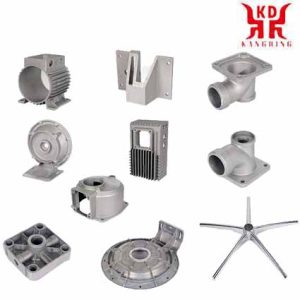
Kina trykstøbning
I trykstøbning, den flydende smelte presses ind i en trykstøbeform (støbeform, hul) under højtryk på ca. 10 til 200 MPa og ved en meget høj formpåfyldningshastighed på op til 12 m / s, hvor det så størkner. Det specielle ved trykstøbeprocessen er den med en permanent form, dvs. H. uden model. Som resultat, formen produceres kun én gang til en række identiske komponenter, men med en væsentlig højere produktionsindsats. På denne måde, opnås et højt output, især i en varmkammer trykstøbemaskine, hvor støbebeholderen og støbestempelet konstant er i smelten. I tilfælde af legeringer med et højere smeltepunkt, koldkammertrykstøbeprocessen anvendes; støbesættet er placeret uden for den metalliske smelte.
Hvordan fungerer højtryksstøbeprocessen?
I højtryksstøbeprocessen, smeltet metal eller metallegering sprøjtes ind i formen ved høj hastighed og højt tryk.
Horisontale højtryksstøbemaskiner sikrer, at matricen er helt lukket. De er klassificeret efter mængden af klemkraft, de kan anvende og kan variere fra 550 til 5700 tons.
Depending on the metal used, the injection unit that fills the mold can be either a hot chamber or a cold chamber. In hot chamber die casting, the metal is held within the die casting machine itself, then it is drawn into the chamber and the action of the injection piston introduces it into the mold. These parts of the machine are always in contact with the molten metal.
In the cold room process, the metal is first melted in a separate furnace and transferred to a holding furnace; derefter hældes det i et fyldekammer og sprøjtes ind i formen. tilbyder et bredt udvalg af koldkammer højtryksstøbemaskiner.
Trykstøbning konkurrerer med sprøjtestøbning med plast. Metalliske materialer har fordele i enkelte tilfælde, som sikrer markedet for trykstøbte artikler.
De mest brugte materialer er
Aluminium (trykstøbt aluminium)
Zink (trykstøbt zink)
Magnesium (trykstøbt magnesium)
Silicium tombac
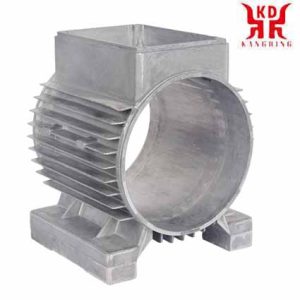 Motorhus trykstøbning |
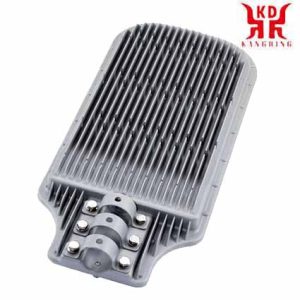 Gadelampe trykstøbning |
 Fordelingsboks trykstøbning |
Egenskaber for trykstøbte dele
Trykstøbte dele har glatte, rene overflader og kanter. Ud over, denne metode tillader vægtykkelser at være tyndere end andre metoder. Med zink, for eksempel, delene kan have en godstykkelse på 1 mm og med aluminium af 1.4 mm, i særlige tilfælde endnu mindre end 1 mm.
De opnåelige tolerancer er ± 0.05 til ± 0.15 mm, so that one speaks of an exact or finished casting. For large cast parts, imidlertid, slightly larger tolerances are required.
It is possible to use parts made of other materials, såsom. B. sockets, threaded bolts or pins to be poured in. Internal threads are produced directly with rotatable steel cores, which can then be removed again later. In contrast to other processes, the casting is called “shot” here. It is possible to carry out up to 1000 shots per hour (depending on the size of the machine). Depending on the casting material, the mold life is up to 2,000,000 shots (zinc alloys).
With aluminum, service lives of approx. 80,000 til 200,000 shots are achieved. I lang tid, die-cast aluminum was considered unsuitable for fusion welding and heat treatment. In the meantime, extensive investigations have made it possible to manufacture die-cast aluminum that is suitable for fusion welding and heat treatment. The particularly low-warpage beam welding processes (electron beam and laser beam welding) should be emphasized here – for optimum strength properties. Imidlertid, for optimal results it is necessary and advisable to consider the requirements of the process when designing. Ud over, imidlertid, die-cast aluminum can also be welded very well using friction welding processes such as friction stir welding.
Die casting machine
Die casting machines usually consist of a mold clamping unit that is used to open and close the die casting mold. Components of the mold clamping unit (also called the closing part) are:
a fixed machine plate (also called a fixed plate) to hold the fixed casting mold half and, in the cold chamber process, the casting set
a movable machine plate (also mobile plate) to accommodate the hydraulic ejector and the movable mold half
the four guide pillars on which the movable machine platen is guided
the toggle lever system (consisting of a cylinder plate (also called crosshead), short and long lever and cross head)
the lock cylinder
The liquid metal is pressed from the casting chamber into the mold with a casting piston. Depending on the type of machine used, a distinction is made between the warm and cold chamber processes. The casting piston is driven by the casting unit’s drive. The drive piston is usually acted upon by a hydraulic pressure accumulator. In some cases the plunger is driven electrically.
Die casting machine peripherals
The peripheral units work in the vicinity of the die casting machine. These are process engineering devices that are necessary for the automatic process to run.
Mold spray machine or manipulator for mold spray or fixed nozzles
Heating and cooling devices
Extraction devices
Dosing oven or ladle
Vacuum-assisted die casting process
The vacuum-assisted die-casting process with forced ventilation enables workpieces with little or no gas inclusions. The cavity and the filling chamber are evacuated at the start of casting, so that the air contained therein and the gases produced are sucked out during casting and so fewer or no air inclusions can form in the melt.
Die casting recompression
A similar effect is achieved here by high compression in the phase before the final solidification of the workpiece. Porer og luftlommer er væsentligt reduceret.
Som under størkningen af smelten. h er der et spring i volumen under overgangen fra væske til fast stof, volumenunderskud forekommer uundgåeligt i det indre af tykvæggede komponenter.
For at kompensere for denne effekt af væskesvind, den såkaldte squeeze-proces kan bruges til at komprimere den størknende smelte. Til dette formål, den pulpagtige smelte komprimeres ved hjælp af en "squeeze pin" i trykstøbeformen i områder, hvor der forventes et volumenunderskud.
Trykstøbeform og værktøj
De støbeværktøjer, der kræves i støbeprocessen, fremstilles i værktøjsværkstedet eller i støbeværkstedet. Specialmaterialer eller højstyrke varmebearbejdningsstål i henhold til DIN EN ISO 4957 are usually used as the material for the casting molds. A selection is shown in the following table.
| Short material name | Material number |
| 32CrMoV 12-28 | 1.2365 |
| X37CrMoV 5-1 | 1.2343 |
| X40CrMoV 5-1 | 1.2344 |
Die casting phase sequence
I trykstøbning, a pre-tempered (100 til 300 grader celsius) permanent mold (two or more parts) is filled with molten metal under pressure at high speed. The actual casting process can be divided into three phases.
The pre-filling phase is used to convey the melt in the casting chamber up to the gate. The air compressed in the sprue system during the first phase can escape through ventilation channels and through the molding plane due to the relatively low speed of the piston (0.05–0.7 m / s).
During the mold filling phase, the casting piston presses the melt into the mold at a very high speed (0.4–6 m / s). The mold filling time is extremely short at 5–60 ms. It is therefore practically impossible to vent the mold.
In the holding pressure phase at the end of the mold filling, a very high static final pressure is built up. The air trapped when the mold is filled is compressed and the cast part is replenished.
Casting pressure
Different casting materials each require a different casting pressure. Aluminum and magnesium alloys are cast at 300–1200 bar, zinc at 130–250 bar and brass at 300–1000 bar. The strength of a workpiece is greater at high casting pressure.
 Surface treatment of die castings |
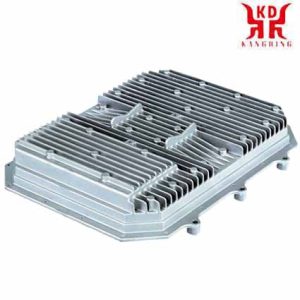 Trykstøbning af radiatorskal |
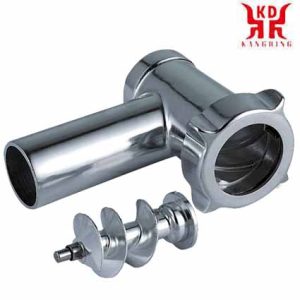 Die casting of meat grinder shell |
Shrinkage behavior of aluminum-silicon melts
If you pour liquid aluminum at about 700 ° C into a mold cavity in such a way that the mold is exactly filled, then the volume of the metal decreases to room temperature by a total of about 1.3% due to its contraction. Of this total, 0.05% is due to the liquid contraction, 0.75% to the solidification and 0.5% to the solid contraction.
This volume deficit of 1.3%, which is not much smaller with aluminum alloys than with pure metal, becomes noticeable in the solidifying cast part in the form of volume defects. In addition to normal shrinkage, these defects occur partly as sink marks, partly as macro-blowholes or as shrinkage pores.
The shrinkage cannot take place as unhindered in a die casting mold as it is in a sand casting mold, for eksempel. In foundry technology, the term “svind” means, in addition to a process, a measure, namely the percentage dimensional deviation of the cooled casting from the dimensions of the mold at operating temperature. Whether shrinkage can take place freely or with hindrance depends almost exclusively on the geometric shape of the cast part. It is therefore possible that the shrinkage rate of 0.5% that is generally used today can be used for many dimensions on one and the same cast part, while 0.4% could still be too much for other areas. The mold dimensions are to be determined taking into account a shrinkage drawing of the die-casting alloys concerned.
Shrinkage for die casting
| Die-cast alloy | Shrinkage in% |
| Aluminum alloys | 0,5–0,7 |
| Magnesium alloys | 0,5–0,8 |
| Zinc alloys | 0,4–0,6 |
Influence of the alloying elements in aluminum casting alloys
Silicon
struktur
With 12.5% silicon, aluminum forms a eutectic1 that melts at 577 ° C. In the binary system there is no connection between aluminum and silicon. The solubility of silicon in solid aluminum is 1.65% in equilibrium at 577 ° C., drops to 0.22% at 300 ° C. and even further at lower temperatures. If an alloy has more silicon than the solubility corresponds, the structure contains not only aluminum mixed crystals but also silicon crystals. If the cooling rate is not particularly fast, the silicon solidifies in the eutectic mixture in the form of angular crystals, needles and plates. These forms of training are made possible by small admixtures of z. B. sodium, strontium, antimony or phosphorus influenced. Die casting causes similar effects due to the rapid solidification.
Eutectic1 is a mixture of alloying elements, which of all possible compositions has the lowest melting point. The eutectic point, f.eks. F.eks .: an Al-Si alloy, is 12.5% og 577 ° C.
Casting properties
The higher the Si content, the more advantageous it has on the flow and mold filling capacity. The flowability deteriorates as the Si content decreases.
Influence of silicon on the feeding behavior
With an increasing Si content, over 11%, the macro-void volume increases sharply. The incidence volume runs in the opposite direction to the macro void volume. With less than 9% Si, thick-walled parts tend to have suction cavities. The feeding options for macro-blowholes are limited in die casting (thick-walled cast parts lying from the gate cause some problems, since accumulations of material during the shot are filled last and then solidify). In hypoeutectic alloys, coarse grain becomes noticeable as a result of overheating from suction points.
A near-eutectic melt (around 11% Si) causes stronger macro-voids. Eutectic and near-eutectic Al-Si melts, which lead to a “granular” or “refined” structure, solidify with the formation of a peripheral shell (exogenous solidification), so that these melts are not susceptible to sucking holes.
jern
A higher iron content has a positive effect on die casting (e.g., alloy EN AC-AlSi9Cu3 (Fe) max. 1.2%), as it reduces the tendency of the metal to stick to the mold surface. Within the tolerance limits, iron normally has no influence on the casting properties. Unintentional increase due to improper melting or working methods in the foundry can lead to embrittlement of the cast parts and undesired formation of cavities, hot cracks or sink marks. At low holding and pouring temperatures, gravity segregations often occur, which collect on the floor of the furnace. The segregation products consist of iron, manganese and silicon. The hardness of segregation products is 500–1000 Vickers.
kobber
Copper additives reduce the solidification shrinkage. Som resultat, copper-containing Al alloys permit pressure-tight castings more easily. Cu additives have a positive influence on strength and machinability. Copper reduces the corrosion resistance.
manganese
Manganese addition of a few tenths of a% reduces the negative influence of iron on elongation and impact resistance. Imidlertid, if iron and manganese occur in a higher content, they can under unfavorable melting conditions, f.eks. B. by low holding temperatures, lead to hard segregation.
magnesium
With the simultaneous presence of silicon, copper or zinc, magnesium leads to an improvement in machinability due to an increase in hardness. Magnesium has no negative influence on the corrosion behavior. Magnesium is also becoming more and more interesting in the automotive industry, especially because of its lower weight.
nikkel
The most important advantage of the addition of nickel is the increase in heat resistance. Pistons and cylinder heads in particular are the main areas of application for nickel-containing aluminum alloys.
zink
Different zinc content within the tolerance limits are generally without any influence. I trykstøbning, the Zn content together with magnesium is occasionally reduced in parts prone to hot cracks.
titanium
Titanium is added to Al alloys mainly as a grain refiner up to a maximum of 0.15%. In the case of sand and permanent mold casting alloys, det er en kornraffinerende legeringskomponent.
at føre
I fast tilstand, bly er uopløst i form af fine dråber. Within the tolerance limits (<0.1%), Pb påvirker ikke legeringsegenskaberne mærkbart.
tin
Med et indhold på mere end 0.02%, tin adskilles langs korngrænserne og har en meget negativ effekt på varm revneadfærd, hvis den normale tolerance overskrides – især inden for trykstøbning.
Sammenligning af trykstøbning og sprøjtestøbning
Investeringsomkostningerne for støbemaskiner og de høje fremstillingsomkostninger for formen er nogenlunde sammenlignelige. I begge processer, et stort antal stykker skal retfærdiggøre disse høje investeringsomkostninger. Efter det, råvareomkostningerne har prioritet.
Trykstøbte metalkomponenter har en væsentlig højere bøjningsstyrke (stivhed) end sprøjtestøbte; det kan være op til 20 gange højere. De emner, der fremstilles ved trykstøbning, kan stadig blive udsat for belastninger ved højere temperaturer (aluminium op til ca. 450 ° C). I tilfælde af sprøjtestøbte materialer, styrken og stivheden falder kraftigt ved højere temperaturer (fra 100 ° C); de eneste undtagelser er dyre specialplast. En anden fordel er, at når komponenterne (med undtagelse af zink) er stressede, der er ingen kryb, som det er tilfældet med mange sprøjtestøbte emner. Trykstøbte dele har en meget bedre strukturel stabilitet, dvs. en mekanisk bearbejdet overflade forbliver en overflade, hvorved overfladen af en plastdel deformeres meget lettere. desuden, nogle sprøjtestøbte plastik ændrer form under klimatiske forhold. Trykstøbte materialer har elektromagnetisk afskærmning og er modstandsdygtige over for organiske opløsninger. Ud over, genbrug er muligt uden tab af kvalitet.
Injection molded components are cheaper if standard materials are used. Ud over, color can be used for injection molding. Another advantage is the lower weight compared to die-cast workpieces. The latter also have poorer corrosion properties. desuden, the production of die-cast metal components is more complex and “complicated” geometries are sometimes not possible.
 English
English العربية
العربية 中文(漢字)
中文(漢字) Čeština
Čeština Dansk
Dansk Nederlands
Nederlands Suomi
Suomi Français
Français Deutsch
Deutsch Italiano
Italiano 日本語
日本語 ಕನ್ನಡ
ಕನ್ನಡ 한국어
한국어 Português
Português Русский
Русский Slovenčina
Slovenčina Español
Español Svenska
Svenska Türkçe
Türkçe

